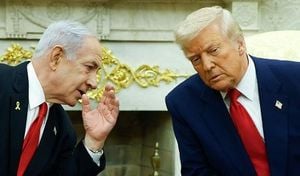As Prime Minister Narendra Modi embarks on a high-profile visit to Tamil Nadu and Andhra Pradesh this week, the spotlight has fallen on both the political and agricultural landscapes of India. The visit, scheduled for November 19, 2025, comes at a pivotal time for Tamil Nadu's farmers and the broader national conversation on India's cultural identity and economic trajectory. The events of the past few days have woven together themes of agricultural prosperity, political strategy, and renewed calls for cultural pride, all set against the backdrop of recent electoral victories and ongoing policy debates.
On November 18, 2025, Tamil Nadu Chief Minister M.K. Stalin penned a letter to Prime Minister Modi, putting forth three urgent demands on behalf of the state’s farmers. The timing was deliberate, with Modi’s itinerary including a stop in Coimbatore for the inauguration of the South India Natural Farming Summit. Stalin’s letter, shared publicly via social media, underscored both the urgency and the scale of Tamil Nadu’s agricultural achievements this season.
Chief among the demands was a revision to the rice procurement target for the Kharif 2025-2026 season. The central government had set the target at 16 lakh metric tonnes, but Stalin argued that the actual production and procurement levels warranted a significant upward adjustment. According to data from the Tamil Nadu Civil Supplies Corporation, the state had already procured 14.11 lakh metric tonnes of paddy as of November 17, 2025—nearly triple the amount procured in the previous year during the same period. In fact, the 2024-2025 procurement stood at just 4.81 lakh metric tonnes, making this year’s figure a record in the state’s history.
Stalin’s letter did not mince words about the stakes for farmers. He wrote, “As of the day before yesterday, the procurement of paddy, which was 4.81 lakh metric tons in 2024-2025 has increased to 14.11 lakh metric tons this year. This is a new record in the history of Tamil Nadu in the procurement of paddy in the Kharif season.” The numbers tell a compelling story: 1,932 direct paddy procurement centres have been opened, compared to 1,095 last year, and 1,86,674 farmers have benefited from the process. The financial impact is equally impressive, with Rs. 3,559 crore already disbursed to farmers.
Stalin’s second demand addressed the technicalities of crop procurement. Following an assessment by central teams on October 25, 2025, he called for an urgent relaxation of the moisture content limit for paddy, from 17% to 22%. The request is rooted in the realities of the North East Monsoon and the bumper harvest, with the CM emphasizing that “orders have not yet been issued by the DFPD, GoI for relaxing the moisture content from 17 % to 22%, this needs to be done urgently.”
The third demand was operational: Stalin sought permission to increase the packing size of Fortified Rice Kernels from 25 kg to 50 kg and the sample lot size from 10 metric tonnes to 25 metric tonnes. These changes, he argued, would streamline logistics and better reflect the scale of current production.
Looking ahead, the state government projects a surplus of 98.25 lakh metric tonnes of paddy and 66.81 lakh metric tonnes of rice available for sale until August 2026. Last August, Tamil Nadu had recommended that the Union Food and Public Distribution Department set the rice procurement target at 20 lakh metric tonnes for the Kharif Marketing Season (KMS) 2025-2026. However, the central government maintained the target at 16 lakh metric tonnes up to March 31, 2026. Stalin’s letter makes it clear: the state wants the freedom to match procurement targets with actual output.
Prime Minister Modi’s visit is not solely about agricultural policy, though. His agenda includes a stop in Puttaparthi, Andhra Pradesh, where he will pay homage at the Mahasamadhi of Bhagwan Sri Sathya Sai Baba and participate in the centenary celebrations. There, Modi will release a commemorative coin and a set of stamps in honor of Sai Baba’s legacy before heading to Coimbatore for the farming summit. During the summit, he is expected to release the 21st installment of PM-KISAN, a national income support scheme, amounting to over Rs 18,000 crore to benefit 9 crore farmers across India.
Meanwhile, the national conversation has also been shaped by Modi’s recent speech at the sixth Ramnath Goenka Lecture, organized by The Indian Express on November 18, 2025. Despite suffering from a severe cold and cough, Modi delivered an address that drew praise from some unexpected quarters, including Congress leader Shashi Tharoor. Tharoor, who attended the event, later shared his reflections on social media, noting that the Prime Minister’s remarks “addressed crucial themes and urged the nation to stay driven toward advancement.”
Modi’s speech focused on challenging the legacy of Thomas Macaulay, whose educational policies in colonial India have long been criticized for fostering what Modi called a “slave mentality.” The Prime Minister called for a decade-long nationwide effort to revive pride in India’s culture, languages, and traditional knowledge systems. “We must break free from the colonial mindset imposed by Thomas Macaulay,” Modi asserted, emphasizing that the next ten years are critical for reshaping the country’s collective outlook.
Tharoor highlighted another key theme from the speech: Modi’s insistence that he is not merely in “election mode,” as critics often allege, but rather in an “emotional mode” focused on addressing people’s concerns. According to Tharoor, Modi’s words were, “I am driven by an emotional mode focused on addressing people’s concerns.” The Congress leader, who has sometimes faced criticism from within his own party for acknowledging Modi’s initiatives, described the Prime Minister’s “dynamism and energy as valuable assets for the nation.”
The political context of Modi’s speech cannot be ignored. It came just days after the National Democratic Alliance (NDA), led by Modi’s Bharatiya Janata Party (BJP), secured a sweeping victory in the Bihar Assembly elections, winning 202 of 243 seats. The Congress party, by contrast, managed only six victories out of the 61 seats it contested—a stinging defeat that has prompted soul-searching within the opposition ranks. Tharoor’s praise for Modi, while unusual, reflects the complex interplay of admiration and rivalry that characterizes Indian politics today.
As the Prime Minister travels south, the convergence of agricultural achievement, political momentum, and calls for cultural renewal promises to shape the days ahead. For Tamil Nadu’s farmers, the hope is that their record-breaking harvest will be matched by responsive policies from the center. For Modi, the challenge is to translate electoral success and rhetorical vision into tangible progress—on the ground and in the hearts of the people.
In a moment when India’s fields are brimming and its political stage is charged with both competition and cooperation, all eyes turn to Coimbatore—and to what promises to be a consequential visit by the country’s most prominent leader.




